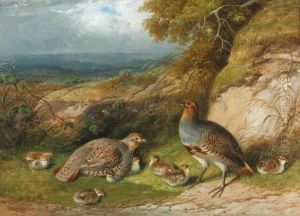F. Rolfe Paintings
Frederick William Rolfe, better known as Baron Corvo, and also calling himself 'Frederick William Serafino Austin Lewis Mary Rolfe', was an English writer, artist, photographer, and eccentric. He was born on July 22, 1860, in Cheapside, London. Although he is not primarily known for visual arts, his creative pursuits were diverse, and they included writing, painting, and photography.
Rolfe’s upbringing was marked by a strong religious influence, which later played a significant role in his works. He was educated at the Ushaw College in Durham, a seminary for English Catholics. His early ambitions lay in becoming a Roman Catholic priest, but this was not to be realized due to various reasons, including his personal conflicts with church authorities. These experiences, along with his travels, would later heavily influence his novel 'Hadrian the Seventh', where the protagonist, much like Rolfe himself, becomes a pope.
After failing to become a priest, Rolfe left England for Italy, which he had developed a fascination for. Italy's art, culture, and landscape became central themes in his work. He was a prolific letter writer, often penning correspondence filled with elaborate tales of his own grandeur and fantasies, which sometimes overshadowed his literary works. His lifestyle was unconventional, and he often found himself in financial straits, relying on the support of benefactors whom he frequently alienated with his volatile temperament and tendency towards acerbic criticism.
Rolfe's most enduring legacy is his writing, which includes not only 'Hadrian the Seventh' but also other works such as 'The Desire and Pursuit of the Whole' and 'Stories Toto Told Me'. His novels often include autobiographical elements and are characterized by their unique prose style and use of elaborate, arcane language.
As an artist, Rolfe’s contributions were less prominent, but he did produce a number of paintings and photographs. His artworks, similar to his written works, reflect his deep engagement with Catholic themes and his affection for Italy. While his paintings were not widely recognized during his lifetime, they contribute to the overall understanding of Rolfe’s multifaceted artistic identity.
Rolfe's life was often troubled and tempestuous, and he died in relative obscurity on October 25, 1913, in Venice, Italy. Despite his death at the age of 53, his legacy lived on through the posthumous publication of his works and the fascination with his flamboyant and tragic life. Interest in Rolfe's life and work resurged in the 20th century, leading to a reevaluation of his place in English literature. Today, he is regarded as a minor but interesting figure in the world of letters, notable for his unique literary voice and his colorful, if not always happy, life.
